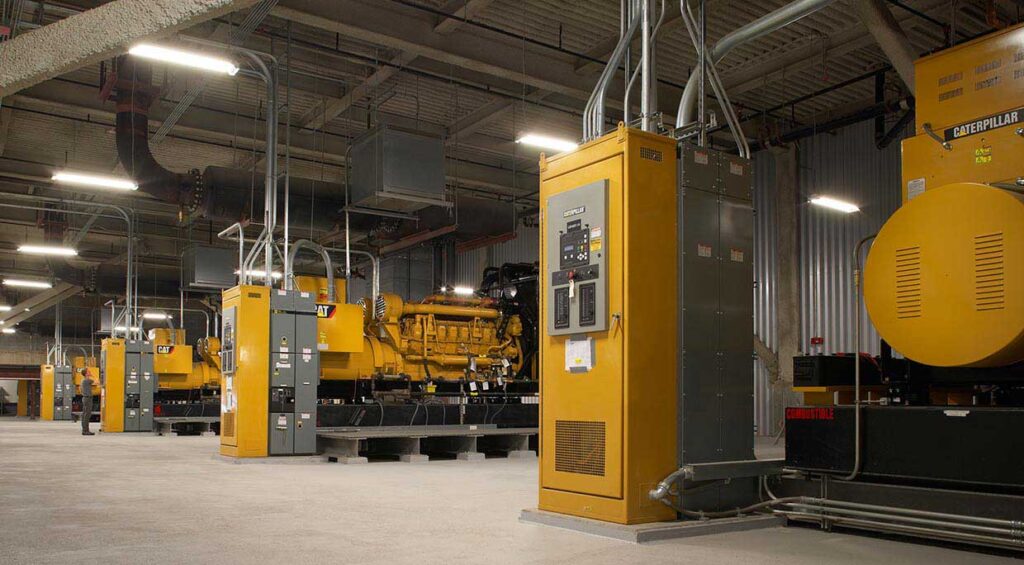Space considerations for emergency gensets often aren’t prioritized in initial building designs, leading to challenges in accommodating the necessary installation areas.
Power house company recommends early consultation with experts during the building or facility design phase to ensure the genset operates effectively with its equipment and surroundings.
Main causes of noise in genset operation
The operation noise from a generator set can seriously damage the surrounding environment if appropriate noise control measures are not put in place.
Noise control measures need to be enforced in order to protect and improve the quality of the environment. The diesel generator set’s main sources of noise are the diesel engine, which includes:
1- Exhaust noise is a type of pulsating airflow noise characterized by high temperature and velocity.
It constitutes the majority of engine noise, often exceeding 100dB, making it a significant component of overall engine noise. During generator operation, exhaust noise is directly expelled through the exhaust pipe. As airflow speed increases, the noise frequency also rises, impacting the quality of life and work for nearby residents.
2- Mechanical noise and combustion noise: stem from the engine’s moving parts and combustion process, respectively. Mechanical noise results from the vibration or impact of engine components due to changes in gas pressure and inertia forces.
Combustion noise arises from structural vibrations during diesel combustion. Both types of noise propagate over long distances with minimal attenuation.
3- Cooling fan and exhaust noise consist of eddy current noise, rotating noise, and mechanical noise generated by the unit’s cooling fan. These noises, along with exhaust noise and airflow noise, are transmitted through the exhaust channel, contributing to environmental noise pollution.
4- Inlet noise originates from the air inlet channel, which facilitates engine operation and heat dissipation. While ensuring smooth airflow into the machine room, the air inlet channel also allows mechanical and airflow noises from the unit to escape outside.
5- Foundation vibration can transmit a diesel engine’s mechanical vibrations to outdoor areas through the foundation, amplifying noise levels as they radiate through the ground.
Methods to separate the generator room
Isolating generator rooms is crucial for several reasons, including noise reduction, safety, and proper ventilation.
Here are steps to effectively isolate a generator room:
1- Select an Appropriate Location:
Choose a location for the generator room that is away from sensitive areas where noise could be a disturbance. Ideally, it should be separate from occupied spaces to minimize noise pollution and ensure safety.
2- Soundproofing:
Install soundproofing materials such as acoustic panels, soundproof doors, and insulation to minimize noise transmission from the generator room to surrounding areas. Ensure that the materials used comply with safety regulations and are fire-resistant.
3- Ventilation System:
Install a proper ventilation system to ensure adequate airflow within the generator room. This is essential for dissipating heat generated by the generator and maintaining safe operating temperatures. Consider using soundproof vents or baffles to reduce noise transmission through ventilation openings.
4- Seal Openings:
Seal any gaps, cracks, or openings in the walls, floors, and ceiling of the generator room to prevent sound leakage. Pay special attention to doors, windows, and ventilation ducts, as these are common areas where sound can escape.
5- Vibration Isolation:
Use vibration isolation mounts or pads to minimize the transmission of vibrations from the generator to the building structure. This helps prevent noise and structural damage caused by excessive vibrations.
6- Emergency Exits:
Ensure that the generator room has proper emergency exits and meets safety codes and regulations. This is crucial in case of emergencies such as fire or equipment malfunction.
7- Regular Maintenance:
Regularly inspect and maintain the generator and isolation measures to ensure they remain effective over time. This includes checking for wear and tear, replacing worn-out components, and cleaning ventilation systems to prevent blockages.
8- Safety Measures:
Install appropriate safety features such as fire suppression systems, smoke detectors, and emergency lighting to ensure the safety of personnel working in the generator room.
By following these steps, you can effectively isolate a generator room to minimize noise transmission, ensure safety, and maintain proper ventilation.
Power house services
Ensuring reliable power is vital for various facilities, especially critical ones like hospitals and data centers. Outages can disrupt crucial services and cause significant losses.
That’s why many decision-makers are investing in power generator sets (gensets) to maintain operations during emergencies.
However, simply having a generator isn’t enough. To function effectively, it needs to be placed and operated correctly.
This is where Powerhouse comes in. We can help you with all aspects of genset implementation, from selecting the right unit to ensuring it’s housed in a properly designed room.
FAQ
How to reduce generator noise?
1- Increase the distance between the generator and the area you want to quieten.
2- Use a rubber mat to absorb vibrations.
3- Plywood or acoustic panels can deflect noise.
4- Replace a faulty muffler for better noise dampening.



